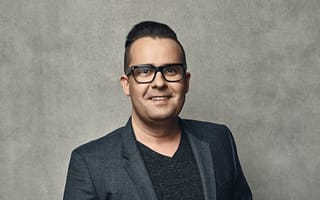
Just like the director on a bustling movie set, a tech leader’s vision drives everything. But a great script isn’t worth much without flawless execution.
With that in mind, we talked shop with three LA tech leaders to find out what technologies they’re utilizing, the accomplishments they’re most proud of and the tech developments they’re keeping an eye on.
Tamara Mellon, a direct-to-consumer women’s luxury shoe company, is the eponymously named brainchild of fashion icon and Jimmy Choo co-founder Tamara Mellon. The company cuts out retailers — and the usual price markup associated with designer shoes — while also providing a complimentary cobbler concierge service for cleaning and repairs. No stranger to the concept of a revamp, CTO Tom Dean walked us through Tamara Mellon’s site relaunch.
Which technologies power your business, and why did you choose them?
Our stack uses Java, Python, JavaScript, Node.js, Postgres, Redshift and ElasticSearch. We’ve recently migrated to a GraphQL API to support React on the front end and back end with server-side rendering. This has allowed us to make our software development faster and simplify code while removing technical debt.
Java is such a diverse language. There isn’t much you can’t build with it, and all the languages we rely on have amazing open-source ecosystems that we can leverage to get more done than we could by ourselves.
The rapid evolution of JavaScript has made us a bit nervous at times, but it has proven to be invaluable for shipping code and allowing front-end developers to take on projects that may have only made sense for back-end developers before. TypeScript, Flow, ESLint, Babel and other tools have also made the ecosystem more sustainable and, more importantly for our business, dependable.
What are the most important tech developments you’re watching right now?
AI and machine learning. From simple collaborative filtering for product recommendations, improving inventory control for better cash flow management, deploying bots using NLP to provide automated customer service and sales support, to applying object detection to our retail store video feed to identify what products customers pick up, there’s an amazing number of ways to improve existing business processes while also creating new opportunities.
Developer tooling and cloud services are also important. You can be so much more productive and confident with the right tools in place, and with a team doing multiple production deployments a day, this is critical to both our sanity and our goal of doubling growth every year.
We recently relaunched our website with a fresh coat of paint and a rewritten front end, and have had the rare success of metrics improving across the board.”
What’s one project your team completed that you’re most proud of?
We recently relaunched our website with a fresh coat of paint and a rewritten front end, and have had the rare success of metrics improving across the board. Growing by 100 percent every year is an ambitious goal, and keeping our momentum going requires that we have a solid e-commerce platform to support marketing and customer acquisition. The relaunch has put us in a great place to build upon.
Along with introducing webpack and a modern toolchain, we were able to improve site speed by over 20 percent (as measured by time to interactive), increase the number of customers adding to cart by over 25 percent, and improve overall revenue by over 5 percent. Of course, for us developers on the team, the big benefit was having a better foundation to build upon in the future.
Strategy, design and development consultancy Sidebench creates custom software for brands. The company’s team is made up of strategists, product managers and UX specialists who work closely with their clients to identify pain points and come up with solutions that address their users’ needs. What does the company see for the future? Director of Technology Colin Regan said Sidebench is working to position itself as an expert in machine learning.
Which technologies power your business, and why did you choose them?
We currently rely predominantly on React, Node.js and sometimes Rails for web development. It’s rare we build any non-SPA web apps anymore. A plurality of our new mobile development is in React Native, with the balance natively developed in Swift or Kotlin. While we’re fairly opinionated on which technologies we feel are on an upward trajectory and will have widespread support for years to come, this is primarily a business concern. From a technical perspective, we strive to be as open-minded and unbiased as possible, opting for .NET Core, Python, Unity, etc. when the situation warrants it.
I’m always looking for ways to achieve higher levels of abstraction, to keep from solving the same problems over and over again.”
What are the most important tech developments you’re watching right now?
I’m always looking for ways to achieve higher levels of abstraction, to keep from solving the same problems over and over again. Right now, we’re excited about serverless architectures as a means of saving time that would otherwise be spent on server management, deployments, scaling, etc. At an organizational level, we’re working to establish ourselves as experts in machine learning, since we expect it’ll factor into an increasing percentage of our work in the next couple years.
What’s one project your team completed that you’re most proud of?
Working in conjunction with Inland Empire Health Plan and the American Heart Association, we recently finished development on an exciting, feature-rich mobile app designed to keep users engaged and on track with their personal health goals. From a technical perspective, this was a great opportunity to leverage React Native not only as a cross-platform app development framework, but also as a means of injecting shared JavaScript code into existing native iOS and Android apps. We also worked with technical stakeholders on both teams to define the APIs needed to support the app.
OPSkins is an online trading platform that allows gamers to buy and sell virtual assets, including tokens, stickers and skins, with the goal of establishing a centralized location for transactions. Last year, the company launched the Worldwide Asset eXchange (WAX) — an independent platform that aims to make in-game items more accessible to players. Lukas Sliwka, the company’s vice president of engineering, walked us through this recent endeavor.
Which technologies power your business, and why did you choose them?
WAX is harnessing the power of blockchain technology to enable gamers to truly own their virtual in-game items. Previously, when gamers earned or purchased in-game items, these items were held within the game. WAX envisions an item-centric gaming ecosystem made possible by the use of blockchain technology. This requires e-commerce grade blockchain platform performance, so we are adopting a variant of C++-based EOS Blockchain running in a highly optimized and secure Amazon Cloud environment. That helps us ensure we are pioneering blockchain sharding via multiple side chains and implementing an eventual consistency synchronization model with our online services that are powering WAX Express Trade and the OPSkins marketplace.
Everything we build follows microservices architecture with services written in Node or PHP. We rely on Redis write-through caching and Amazon Aurora database storage to boost our performance while keeping DevOps complexity down. On the front end, we standardized our stack on React and React Native frameworks as we encourage our developers to master full-stack engineering using JavaScript technologies. Finally, automation is the key to our ability to move fast with high integrity, so our team invests heavily in frameworks automating regression, load and integration testing.
What are the most important tech developments you’re watching right now?
As a blockchain gaming company, we’re looking at the most recent developments in the blockchain space. Public blockchains have major issues handling a large volume of transactions, meaning any really successful company building on public blockchains will struggle if their product takes off in popularity. We’ve built a purpose-built blockchain for this very reason, and are working around the clock to bring this improved technology to a wider audience so we can all harness the transformative power of the blockchain.
As a blockchain gaming company, we’re looking at the most recent developments in the blockchain space. ”
What’s one project your team completed that you’re most proud of?
WAX recently launched a new virtual gaming item trading marketplace called WAX ExpressTrade, a free and instant peer-to-peer trading service. Instead of listing items for sale or purchasing them, users can simply trade items with one another instantly for free. We’re proud to be able to provide our community with this one-of-a-kind platform to trade with each other without the annoyance of expensive fees. In addition, our engineering department recently rolled out a 100 percent working remote program, allowing our engineers to work from anywhere in the world.







